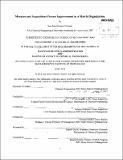| dc.contributor.advisor | J. Christopher Love and Vahram Erdekian. | en_US |
| dc.contributor.author | Cavazos Cavazos, Jose Juan | en_US |
| dc.contributor.other | Leaders for Global Operations Program. | en_US |
| dc.date.accessioned | 2013-01-23T19:43:34Z | |
| dc.date.available | 2013-01-23T19:43:34Z | |
| dc.date.copyright | 2012 | en_US |
| dc.date.issued | 2012 | en_US |
| dc.identifier.uri | http://hdl.handle.net/1721.1/76489 | |
| dc.description | Thesis (M.B.A.)--Massachusetts Institute of Technology, Sloan School of Management; and, (S.M.)--Massachusetts Institute of Technology, Dept. of Chemical Engineering; in conjunction with the Leaders for Global Operations Program at MIT, 2012. | en_US |
| dc.description | Cataloged from PDF version of thesis. | en_US |
| dc.description | Includes bibliographical references (p. 70). | en_US |
| dc.description.abstract | 3M has had aggressive growth through acquisitions. Almost all of the acquisitions add new manufacturing sites to the existing manufacturing and distribution networks. 3M is composed of 38 divisions (as of 2011) with significant independence. There are corporate experts in the different functional areas of due diligence that bring consistency regardless of the division doing the acquisition. However, since manufacturing is not centralized and is managed by each division, there is no corporate expert neither for manufacturing due diligence or supply chain. The difference in the experience level of manufacturing managers in different divisions, and a division-centric view of the supply chain has lead sometimes to integration plans that don't fully take into account opportunities in supply chain rationalization and future manufacturing improvements. The goal of this study is to map the current process and tools across divisions, to identify gaps and to create a business process that can be used as a guideline for all the divisions engaging in acquisitions with a manufacturing component. In addition, a principal components analysis is proposed to find which parameters could predict the outcome of an acquisition. | en_US |
| dc.description.statementofresponsibility | by Jose Juan Cavazos Cavazos. | en_US |
| dc.format.extent | 70 p. | en_US |
| dc.language.iso | eng | en_US |
| dc.publisher | Massachusetts Institute of Technology | en_US |
| dc.rights | M.I.T. theses are protected by
copyright. They may be viewed from this source for any purpose, but
reproduction or distribution in any format is prohibited without written
permission. See provided URL for inquiries about permission. | en_US |
| dc.rights.uri | http://dspace.mit.edu/handle/1721.1/7582 | en_US |
| dc.subject | Chemical Engineering. | en_US |
| dc.subject | Sloan School of Management. | en_US |
| dc.subject | Leaders for Global Operations Program. | en_US |
| dc.title | Mergers and acquisitions process improvement in a matrix organization | en_US |
| dc.title.alternative | M&A process improvement in a matrix organization | en_US |
| dc.type | Thesis | en_US |
| dc.description.degree | S.M. | en_US |
| dc.description.degree | M.B.A. | en_US |
| dc.contributor.department | Leaders for Global Operations Program at MIT | en_US |
| dc.contributor.department | Massachusetts Institute of Technology. Department of Chemical Engineering | |
| dc.contributor.department | Sloan School of Management | |
| dc.identifier.oclc | 822569539 | en_US |
